
Report ID: SQMIG20U2010
SkyQuest Technology's Electronic toll collection market size, share and forecast Report is based on the analysis of market data and Industry trends impacting the global Electronic Toll Collection Market and the revenue of top companies operating in it. Market Size Data and Statistics are based on the comprehensive research by our Team of Analysts and Industry experts.
Electronic Toll Collection Market size was valued at USD 9.6 billion in 2023 and is poised to grow from USD 10.26 billion in 2024 to USD 17.5 billion by 2032, growing at a CAGR of 6.9% during the forecast period (2025-2032).
The primary purpose of the electronic toll collection market is to streamline toll collection processes and improve the overall transportation experience. Several key factors are driving the growth of the electronic toll collection market. increasing urbanization and population growth have led to a surge in vehicle ownership, resulting in higher traffic volumes and the need for efficient toll collection systems. government and transportation authorities worldwide are recognizing the benefits of electronic tolling in terms of reducing traffic congestion, improving air quality, and enhancing overall transportation efficiency. The positive growth trajectory, the electronic toll collection market also faces certain restraining factors. One significant challenge is the initial high implementation cost associated with installing the required infrastructure, such as toll gantries, electronic tags, and back-end systems.
The electronic toll collection market encounters several challenges. One key challenge is ensuring interoperability between different tolling systems, particularly when motorists travel across multiple regions or countries with varying electronic tolling technologies. Standardization efforts and collaborative agreements among toll authorities are crucial to address this challenge. The electronic toll collection market presents significant opportunities for growth and innovation. With advancements in vehicle-to-infrastructure (V2I) and vehicle-to-everything (V2X) communication technologies, there is potential for integrating electronic tolling systems with other smart transportation solutions, such as traffic management systems and connected vehicles. The global electronic toll collection market is driven by the need for efficient toll collection processes, improved transportation systems, and enhanced user experience. While facing challenges such as implementation costs and interoperability issues, the market presents opportunities for innovation and integration with emerging technologies.
REQUEST FOR SAMPLE
Electronic Toll Collection Market size was valued at USD 9.14 Billion in 2023 and is poised to grow from USD 9.74 Billion in 2024 to USD 16.24 Billion by 2032, growing at a CAGR of 6.6% during the forecast period (2025-2032).
The Global Electronic toll collection Market is highly competitive, with several key players vying for market share and striving to offer innovative solutions to meet the evolving needs of the industry. The competitive landscape is characterized by a mix of established companies with a strong market presence and emerging players bringing new technologies and solutions to the market. The global electronic toll collection market is characterized by fierce competition among established players and the emergence of innovative companies. The market's competitive landscape is shaped by companies offering comprehensive tolling solutions, leveraging advanced technologies, and focusing on interoperability, scalability, and customer-centric approaches. The industry's future will likely witness intensified competition and increased collaboration to address evolving market demands and unlock new opportunities in the electronic toll collection sector. 'Kapsch TrafficCom AG (Austria) ', 'Thales Group (France) ', 'Cubic Corporation (US) ', 'Neology, Inc. (US) ', 'Conduent Incorporated (US) ', 'Q-Free ASA (Norway) ', 'Siemens AG (Germany) ', 'Toshiba Corporation (Japan) ', 'Ferrovial (Spain) ', 'Accenture (Ireland) ', 'SICE (Spain) ', 'Efkon AG (Austria) ', 'Mitsubishi Heavy Industries, Ltd. (Japan) ', 'Indra Sistemas (Spain) ', 'Transurban Limited (Australia) ', 'Honeywell International Inc. (United States) ', 'Schneider Electric SE (France) ', 'Hitachi, Ltd. (Japan) ', 'Egis Group (France) ', 'KLD Engineering, P.C. (United States)'
Governments around the world played a crucial role in driving the adoption of electronic toll collection systems. In 2022, several governments initiated or expanded their electronic tolling programs to enhance transportation infrastructure and improve the overall travel experience. For instance, in India, the National Highways Authority of India (NHAI) mandated the implementation of the FASTag program for all toll plazas on national highways. This move aimed to promote cashless transactions, reduce traffic congestion, and enhance toll collection efficiency.
Integration with Connected Vehicles and Mobility Solutions: A significant trend observed in the electronic toll collection market in 2022 was the integration of electronic tolling systems with connected vehicles and mobility solutions. The advancements in vehicle-to-infrastructure (V2I) and vehicle-to-everything (V2X) communication technologies paved the way for seamless interactions between vehicles and tolling systems. This integration enabled features such as real-time toll information, automatic toll payment deduction, and personalized travel recommendations.
North America's dominance in the electronic toll collection market is primarily due to early adoption and a mature market landscape. The United States has been at the forefront of implementing electronic tolling systems, with various state-level programs and interoperable solutions. The E-ZPass system, launched in 1993, covers a significant portion of the northeastern states, facilitating seamless travel and reducing congestion at toll plazas. Similarly, the FasTrak system in California enables efficient toll collection on major highways and bridges. These successful implementations, coupled with robust infrastructure and supportive government policies, contribute to North America's dominant position.
Want to customize this report? This report can be personalized according to your needs. Our analysts and industry experts will work directly with you to understand your requirements and provide you with customized data in a short amount of time. We offer $1000 worth of FREE customization at the time of purchase.
Feedback From Our Clients

Report ID: SQMIG20U2010
sales@skyquestt.com
USA +1 351-333-4748